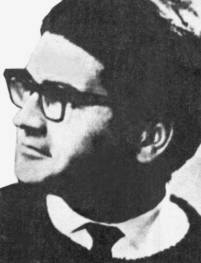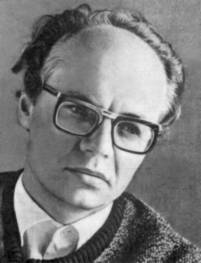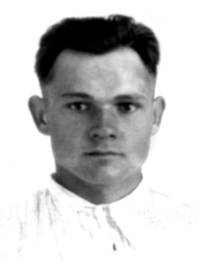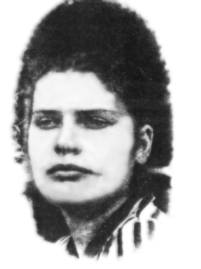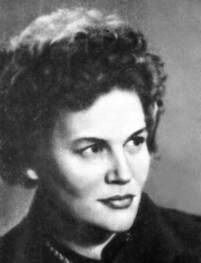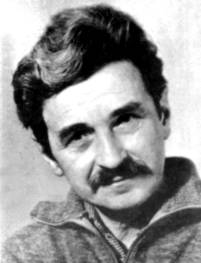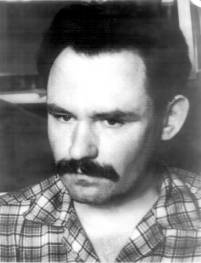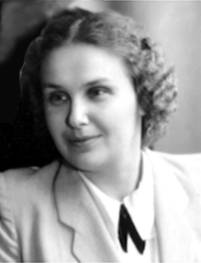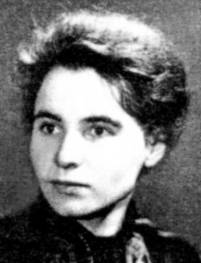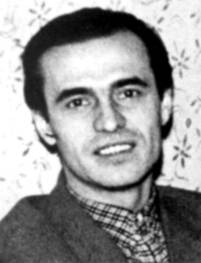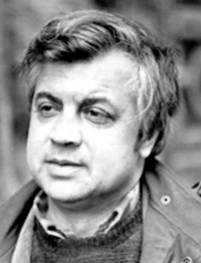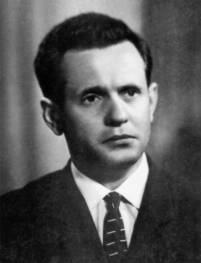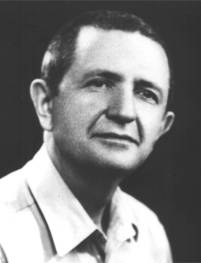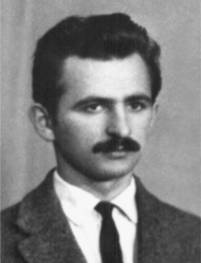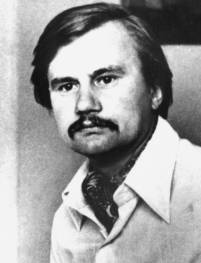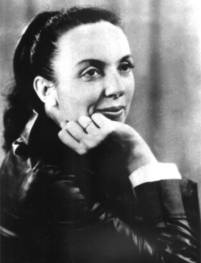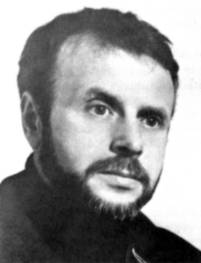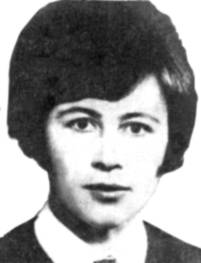The creative work of the Sixtiers was of interest to all strata of Ukrainian society: intellectuals, workers, and peasants. The Sixtier poets were published, and their books were in high demand, while their performances drew full auditoriums. Exhibitions by their artists attracted a large number of people. Ukrainian folk art and music gained unprecedented popularity.
The Sixtiers organized literary readings in private apartments and held various literary and artistic events. Popular meeting places included the workshops of Alla Horska, Ivan Honchar, and other artists.
But, as Kasyanov said, “Cultural activism… firstly, was the initial stage of the Sixtiers’ ideological maturation, and secondly, it required organization.”[1][1]
The center for the Sixtiers became the Club of Creative Youth (KTM) in Kyiv. It was founded in 1960 (formally under the auspices of the city’s Komsomol committee). The club organized sections for cinema, theater, writing, art, and music. The theater section evolved into the unofficial “Second Ukrainian Theater,” and the music section organized Kyiv’s first jazz ensemble. The KTM became the favorite meeting place for the new generation of intellectuals[2][2].
The young director Les Tanyuk was elected president of the club. From the very beginning, the club’s activities went beyond what was permitted. The “Second Ukrainian Theater” staged semi-banned plays by M. Kulish and B. Brecht[3][3]. The artists’ exhibitions were sometimes so unconventional and bold that they were banned even before they opened. There was an instance when city party committee officials personally took down paintings by S. Otroshchenko depicting Carpathian churches that were later destroyed[4][4].
The poetry of Vasyl Symonenko, Ivan Drach, Lina Kostenko, and Mykola Vinhranovsky was very popular; at literary evenings, they caused a sensation, without exaggeration, with their boldness, novelty, and skill.
One of the main tasks of totalitarianism was to cut the people off from their own history, to falsify and distort it. One can imagine the important role played in such conditions by alternative lectures on Ukrainian history, which absolutely did not fit into the framework of the state doctrine—they were delivered by historians Mykhailo Braichevsky and Olena Apanovych. This direction of the club’s work, such as the creative rehabilitation of artists repressed in the 1930s and the study of the historical past, was a priori unacceptable to the regime[5][5].
Despite all this, the activities of the KTM at the beginning of its existence were purely cultural, and the authorities did not create any serious obstacles for it.
The situation was changed by the poets, critics, and publicists—Ivan Svitlychny, Ivan Dziuba, Yevhen Sverstyuk—and the artists—Alla Horska, Lyudmyla Semykina, Viktor Zaretsky, and others. One can agree with H. Kasyanov that it was thanks to them that the KTM’s activities acquired a new meaning—not only cultural and artistic, but also civic. A vivid example of this were the literary and artistic evenings. It is worth recalling the evenings in memory of L. Kurbas and M. Kulish, A. Petrytsky, I. Franko and Lesia Ukrainka, and the evening in memory of Vasyl Symonenko, who died in 1963. Shevchenko evenings were held annually. All of them went beyond cultural activism and were important public events in which open opposition to the regime was already palpable.
“Life in Kyiv at that time was very interesting,” recalls Nadiya Svitlychna. “I still caught the Club of Creative Youth when I used to visit Ivan, and when I moved in 1964, it was just being broken up. I still saw the last Shevchenko evening in March at the October Palace—it was an extraordinary evening. Alla Horska designed the invitations for it… it folded like an accordion into five by five parts, and on each part was written the title of some work or a quote from Shevchenko, and when you turned the last page, two entries would appear side by side, that is, on two separate pages, but they ended up next to each other. And it was: ‘I suffer, I am tormented, but I do not repent,’ and next to it: ‘In a free, new family.’ Later, those invitations were immediately confiscated, even that same evening and later during searches, but mine has survived. The program was very interesting: it was only Shevchenko. Unlike today’s talkers, no one gave any reports, no one read their own works, only Shevchenko’s, and only three poems: ‘The Dream,’ ‘The Caucasus,’ and ‘To the Dead and the Living…’ Ponomarenko was reading… The impression was extraordinary. The atmosphere was simply electrified, and when the authorities, who were of course there, felt that this could end who knows how, and that these people would carry with them from the October Palace… The hall was so silently electrified, and the words: ‘Slaves, lackeys, the filth of Moscow, Warsaw’s trash are your masters…’—and so on… The reaction was explosive.”[6][6]
In the fall of 1962, a commission was created within the club to verify rumors of mass burials of repression victims in Bykivnia. “The members of the commission—L. Tanyuk, A. Horska, and V. Symonenko—arrived in Bykivnia,” describes H. Kasyanov. “The first thing they saw were children playing football with a human skull. After a detailed examination, it turned out that there was a bullet hole in the skull. The stories of local residents completed the horrific picture.”[7][7] A memorandum was drawn up and sent to the city council demanding the creation of a state commission to investigate this crime of Stalinism and to erect a monument to the victims of repression in Bykivnia. H. Kasyanov believes that it was with “this step that the KTM activists finally crossed the line of what was permitted.”[8][8].
The transition from exclusively cultural to civic activities could not but provoke a reaction from the regime. From the fall of 1962, extrajudicial repressions against KTM activists began to gain momentum: the banning of plays, exhibitions, and literary evenings, surveillance, threats, prophylactic talks, and even beatings. Les Tanyuk was removed from the leadership, and Viktor Zaretsky was formally elected president of the club, although Tanyuk continued to manage it in fact[9][9].
In 1962, Kyiv poets I. Drach, M. Vinhranovsky, D. Pavlychko, and critic I. Dziuba traveled to Lviv, where they held evenings at the Writers’ Union and the university.
Mykhailo Horyn recalls one such evening: “Ivan Drach—a young man who was only 25 at the time—read his poem ‘Where Are We Going.’ It was a unique, incredibly bold poem. And it’s simply a miracle how that young man, born in the Dnipro region, a party member, dared to come out with such a programmatic, I would say, poem:
Where are we going? What wave
Drives us against stone winds?
What beast will we violate,
To perish with it in the struggle?
Atomic nails, wise plates
And philosophical dead ends,
And the fat face of a bone-breaker
With a bloody banner in hand.
The image of death, which had always been depicted as skeletal, but here the face of death had become a face with not a red, but a bloody banner, provoked… an extremely lively reaction from the Lviv audience, which was, of course, anti-Soviet.”[10][10].
That same year, Les Tanyuk and Alla Horska came to Lviv. They tried to stage M. Kulish’s play “This Is How Huska Perished” at the M. Zankovetska Theater. The play was banned, and Tanyuk was told to leave the city within 24 hours[11][11].
Soon, Lviv had its own Club of Creative Youth—“Prolisok” (Snowdrop). It was headed by Mykhailo Kosiv, a literary scholar and graduate student at Lviv University. It included psychologist Mykhailo Horyn, his brother, art historian Bohdan Horyn, history student Ivan Hel, and university lecturer Mykhailo Osadchy. Later, poets Ihor Kalynets, his wife Iryna Stasiv-Kalynets, poet Hryhoriy Chubai, artist Stefaniya Shabatura, and others joined “Prolisok.”
Unlike the Kyivans, the Western Ukrainian Sixtiers were a priori convinced anti-Soviets, had empirical experience of confronting the Bolshevik totalitarian machine, and many of them were initially inclined towards underground and even armed struggle in the style of the OUN-UPA.
Ivan Hel says in an interview: “I was a proponent not only of the struggle of the word, but also of armed struggle. And I considered the struggle of the word to be something of an intellectual’s invention.”[12][12].
But during the cultural integration between Kyiv and Lviv, the Kyivans proved the priority of the struggle of the word under the given historical conditions. The Lvivians, in turn, opened their eyes to the horrors committed by the Soviet authorities after seizing Western Ukraine, to the activities of the OUN-UPA, and so on.
As Mykhailyna Kotsiubynska testifies, the real “living bridge” between Kyiv and Lviv was Ivan Svitlychny[13][13]. One of the most famous young poets and non-conformist critics, he was a generator of ideas and the spiritual leader of the Sixtiers. Mykhailo Horyn recalls that it was “Svitlychny who proposed a legal form of struggle—to openly say what we think about the existing regime.”[14][14] He was also the one who established contacts with the Ukrainian diaspora in the West.
From 1963, most of the Sixtier writers were no longer published. The authorities’ response to these measures was the dissemination of works in samvydav and tamvydav. Initially, the Sixtiers were published in Czechoslovakia and Poland, and later in Western Europe, the USA, and Canada. Thus, the culture of the Sixtiers became known to the Western reader. The Munich journal “Suchasnist” (Contemporaneity) played a major role in this process. The “enemy voices”—Radio Liberty, the BBC, the Voice of America—began to talk about the Sixtiers.
In Ukraine itself, critics like Ivan Svitlychny, Ivan Dziuba, Yevhen Sverstyuk, and others could be published for some time, but soon this was also stopped by Soviet censorship. There were cases where famous writers were published under a different name or a pseudonym. From about 1963, the active production and distribution of samvydav began, which had the characteristics of an organized activity. As Ivan Hel said in an interview: “A chain is created: the Kyivans… the Horyns, Hel—we are looking for a struggle. And I am already actively starting to produce and distribute samvydav.”[15][15].
According to M. Horyn, many anti-Bolshevik articles appeared in samvydav at that time. At first, they were politically toothless and cautious, such as “Thoughts and Reflections of a Bewildered Reader.” But by 1964, works with sharp criticism of the regime appeared, for example, “Ukrainian Education in a Chauvinistic Noose,” “The State and Tasks of the Ukrainian Liberation Movement,” “The Derivation of Ukraine’s Rights,” “Ukraine and Moscow’s Ukrainian Policy,” and an article about the trial of Pohruzhalsky, who set fire to the library in Kyiv, etc. “Their appearance already indicated that such an educational, cultural-artistic political movement had formed.”[16][16].
According to Ivan Hel, the Lvivians formulated their program as the “Struggle for the Statehood of Ukraine,” while the Kyivans focused on defending human rights and the cultural rights of the nation[17][17].
Clubs of Creative Youth opened all over Ukraine, including in Odesa and Dnipropetrovsk. Dissident cells of the Sixtiers were created in all major cities of Ukraine.
Very quickly, all these cells came under the surveillance of the KGB. Harassment, moral pressure, surveillance, searches, and finally arrests began. According to the memoirs of the Sixtiers, open, demonstrative surveillance of them began after Brezhnev came to power. Rumors from the KGB about possible judicial repressions had circulated even earlier.
Mykhailo Horyn recalls: “In the summer of 1964, Ivan Drach came to Lviv… And he said: ‘You know, Mykhailo, I had a conversation with a KGB agent, and he said that they are going to take you…’ But time passed, and they didn’t take us. We continued our work. They only took us after Brezhnev came to power in October and preparations began for the crackdown on the movement that had arisen on the soil of, so to speak, the Khrushchev Thaw.”[18][18].
This is also explained by the fact that among the Soviet party leadership there were people who sympathized with the Sixtiers and tried to keep them within the limits permitted by the regime, so that there would be no order from Moscow to apply repressive measures. For example, Petro Shelest—the First Secretary of the CC of the CPU—tried to limit himself to “ideological” measures against opponents of the official course. When Ivan Dziuba wrote his programmatic work “Internationalism or Russification?” and sent it as an addendum to a statement on national policy, on Shelest’s orders, it was duplicated and distributed for familiarization among high-ranking party officials at the level of regional committee secretaries. There is a version that the Secretary of the CC of the CPU for ideological work, Andriy Skaba, suggested that Dziuba write this work[19][19]. Thus, it was only after an order from Moscow that the first arrests took place in late August and early September. Apparently, the author of this order was the then Kremlin’s “gray cardinal,” Mikhail Suslov.
By the time of the arrests, the Sixtiers’ movement had reached the level of public opposition to the regime and became the basis for the further resistance movement.
“We founded a completely different principle of cultural life, we established it. And it was a different morality, a different ethics…,” relates Yevhen Sverstyuk, “I think that if we talk about our opposition in the mid-sixties—it was a moral opposition—certainly, it was an ethical opposition—certainly, it was an aesthetic opposition—certainly. And it was a half-ideological opposition*[*]. As for political or religious opposition, we avoided that, and we avoided it quite consciously—it was completely without prospects.”[20][20].
[1] Kasyanov H. The Dissenters: The Ukrainian Intelligentsia in the Resistance Movement of the 1960s-1980s. – K.: Lybid, 1995. – P. 18.
[2] Ibid. – P. 19.
[3] Ibid. – P. 19.
[4] Ibid. – P. 19.
[5] Ibid. – P. 19.
[6] Audio interview with N. Svitlychna. – Conducted by V. Ovsienko, 1998 // KHPG Archive. – P. 2.
[7] H. Kasyanov. Op. cit. – P. 21.
[8] Ibid. – P. 21.
[9] Ibid. – P. 21.
[10] Audio interview with M. Horyn. – Conducted by B. Zakharov, 1997 // KHPG Archive. – P. 4.
[11] H. Kasyanov. Op. cit. – P. 21.
[12] Audio interview with I. Hel. – Conducted by B. Zakharov, 1997 // KHPG Archive. – P. 4.
[13] M. Kotsiubynska. “Dobrookyi” // Dobrookyi. Memoirs of Ivan Svitlychny. – K.: “Chas” Publishing House, 1998. – P. 108.
[14] Audio interview with M. Horyn. – Conducted by B. Zakharov, 1997 // KHPG Archive. – P. 5.
[15] Audio interview with I. Hel. – Conducted by B. Zakharov, 1997 // KHPG Archive. – P. 4.
[16] Audio interview with M. Horyn. – Conducted by B. Zakharov, 1997 // KHPG Archive. – P. 5.
[17] Audio interview with I. Hel. – Conducted by B. Zakharov, 1997 // KHPG Archive. – P. 4.
[18] Audio interview with M. Horyn. – Conducted by B. Zakharov, 1997 // KHPG Archive. – P. 5.
[19] Alekseeva L. Op. cit. – P. 16.
* Later in the interview, Y. Sverstyuk explains that it was a “half-ideological opposition” because dissidents during this period tried to polemicize with the regime within their system of concepts, rather than creating an alternative ideological, political system.
[20] Audio interview with Y. Sverstyuk. – Conducted by B. Zakharov, 1997 // KHPG Archive. – P. 11.
